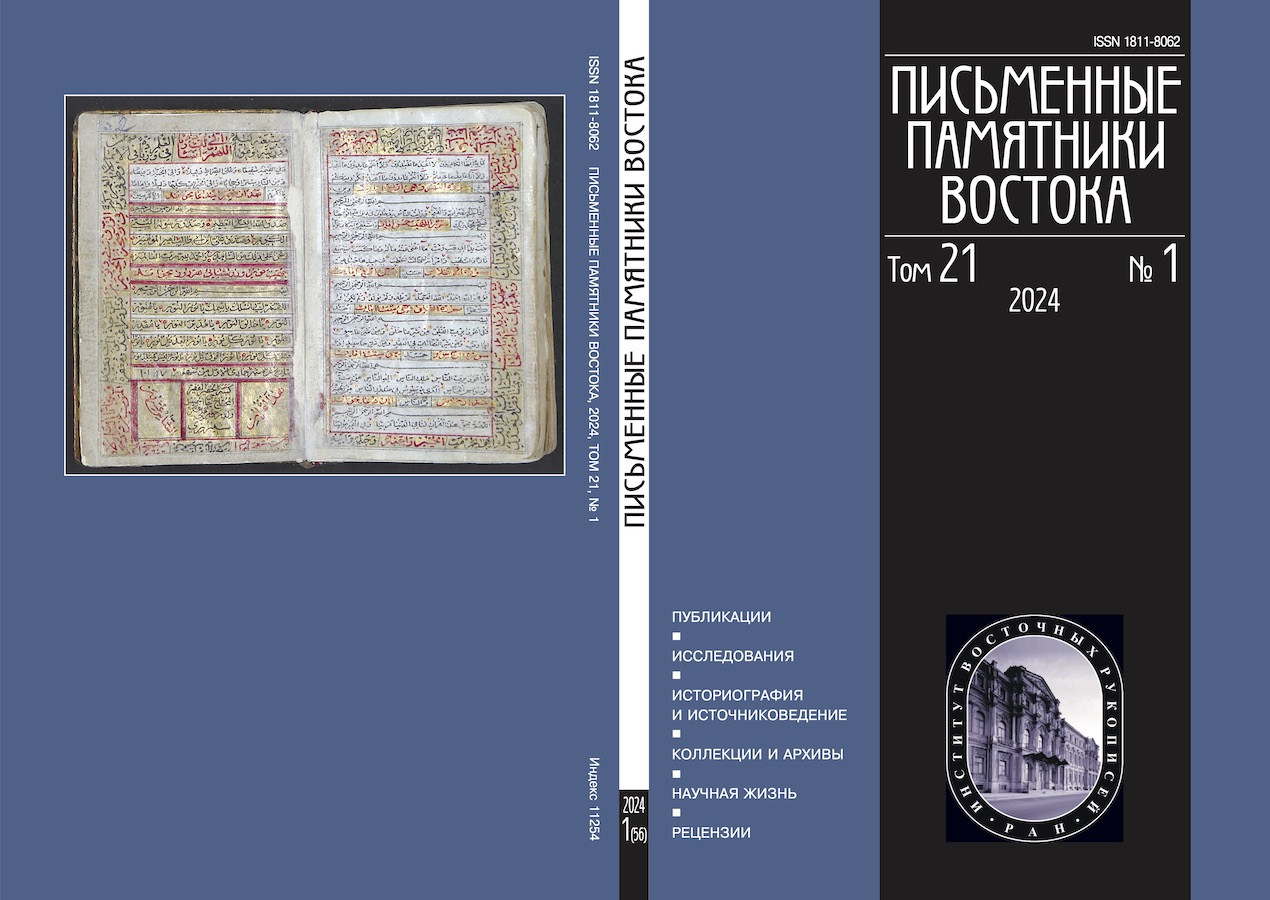An Outline of the History of Korea in The Primer for Children
- Authors: Boltach I.V.1
-
Affiliations:
- Institute of Oriental Manuscripts, RAS
- Issue: Vol 21, No 1 (2024)
- Pages: 27-35
- Section: Publications
- Published: 21.05.2024
- URL: https://journals.eco-vector.com/1811-8062/article/view/627127
- DOI: https://doi.org/10.55512/WMO627127
- ID: 627127
Cite item
Full Text
Abstract
In traditional Korea, The Primer for Children (Dongmong seonseup 童蒙先習) was a basic textbook studied in Confucian schools. It introduced students to the basics of Confucian ethics and to the main events of the history of China and Korea. The text is composed in literary Chinese and marked with Korean auxiliary verbs and affixes written in Chinese characters using the gugyeol method. The Korean Collection of the Institute of Oriental Manuscripts of the Russian Academy of Sciences (St. Petersburg) includes a xylographic edition of this textbook (C 64), which was printed in the year gyechuk 癸丑 (1793 or 1853) and entered the funds of the IOM, RAS, as part of the collection of Academician M.F. Brosset (1802–1880). The paper contains the first partial Russian translation of this textbook presenting the outline of the history of Korea from ancient times to the mid-16th century. The translation is accompanied with a commentary and a brief preface.
About the authors
Iuliia V. Boltach
Institute of Oriental Manuscripts, RAS
Author for correspondence.
Email: julia.boltach@gmail.com
ORCID iD: 0000-0001-9325-7101
Cand. Sci. (History), Senior Researcher at the Department of Far Eastern Studies
Russian Federation, Saint PetersburgReferences
- Bichurin, N.Ia. (Iakinf). Sobranie svedenii o narodakh, obitavshikh v Srednei Azii v drevnie vremena. T. 2 [A Collection of Information on Peoples Who Inhabited Central Asia in Ancient Times. Vol. 2]. [Executive editor S.P. Tolstov; text editing, introduction and commentary by A.N. Bernshtam and N.V. Kiuner]. Moscow–Leningrad: Izdatel’stvo Akademii nauk SSSR, 1950 (in Russian).
- Iren. Ostavshiesia svedeniia [o] trekh gosudarstvakh (Samguk iusa) [Memorabilia of the Three Kingdoms (Samguk yusa)]. Translation from Hanmun, introduction, commentary and indexes by Iu.V. Boltach. St. Petersburg: Hyperion, 2018 (in Russian).
- Kim Busik. Samguk sagi. Letopisi Kogure. Letopisi Pekche. Khronologicheskie tablitsy [Samguk sagi. Goguryeo’s Records. Baekje’s Records. Chronological Tables]. Text editing, translation, introduction and commentary by M.N. Pak. Moscow: Vostochnaya literatura, 1995 (in Russian).
- Kim Busik. Samkuk sagi. Letopisi Silla [Samguk sagi. Silla’s Records]. Text editing, translation, introduction and commentary by M.N. Pak. Moscow: Vostochnaya literatura, 2001 (in Russian).
- Kim Busik. Samguk sagi. Raznye opisaniia. Biografii [Samguk sagi. Monographs. Biographies]. Text editing, translation, introduction, commentary and appendices under the general supervision by M.N. Pak and L.R. Kontsevich. Moscow: Vostochnaya literatura, 2002 (in Russian).
- Kontsevich, Lev R. Slovar’ geograficheskikh nazvanii Respubliki Koreia: spravochnoe posobie [Dictionary of Place Names of the Republic of Korea]. Moscow: Nauka, Vostochnaya literatura, 2018 (in Russian).
- Li Hongjik 李弘稙. Jeungbo sae guksa sajeon 增補 새 國史事典 = Encyclopedia of Korean History. Seoul 서울: Gyohaksa 敎學社, 2001 (in Korean).
- Pak, Mikhail N. “Opisanie koreiskikh plemion v nachale novoi ery (po «San’-go chzhi»)” [Description of Korean Tribes in the Beginning of Our Era (according to “San guo zhi”]. Problemy vostokovedeniia [Problems of Oriental Studies], 1961, vol. 1, pp. 115–138 (in Russian).
- Rybakov, Viacheslav M. Tanskaia biurokratiia. Chast’ 1: Genezis i struktura [Tang Bureaucracy. Part 1: Genesis and Structure]. St. Peterburg: Peterburgskoe Vostokovedenie, 2009 (in Russian).
- Sae okpyeon 새옥편 (A New Chinese-Korean Dictionary). Ed. by Hong Gimun 홍기문. Pyongyang 평양: Gwahagwon chulpansa 과학원 출판사, 1963 (in Korean).
- Syma Tsian’. Istoricheskie zapiski (“Shi tszi”) [Records of the Grand Historian (Shiji)]. Vol. 2. Translation from Chinese and commentary by R.V. Viatkin and V.S. Taskin; under the general supervision by R.V. Viatkin. Moscow: Nauka, Glavnaia redaktsiia vostochnoi literatury, 1975 (in Russian).
- Syma Tsian’. Istoricheskie zapiski (“Shi tszi”) [Records of the Grand Historian (Shiji)]. Vol. 1. Translation from Chinese and commentary by R.V. Viatkin and V.S. Taskin; under the general supervision by R.V. Viatkin; introduction by M.V. Kriukov. 2nd ed. Moscow: Nauka, Glavnaia redaktsiia vostochnoi literatury, 2001 (in Russian).
- Toegyeongdang Gwon Sangno 退耕堂 權相老. Han’guk jimyeong yeonhyeok sajeon 韓國地 名沿革事典 (A Dictionary of Changes in Korean Place Names). Seoul 서울: Ihwa munhwa chulpansa 이화 문화 출판사, 1994 (in Korean).
- Trotsevich, Adelaida F. & Gur’eva, Anastasia A. Opisanie pis’mennykh pamiatnikov koreiskoi traditsionnoi kul’tury. II: Koreiskie pis’mennye pamiatniki v rukopisnom otdele Instituta vostochnykh rukopisei Rossiiskoi akademii nauk [Description of Manuscripts and Block-Prints of Korean Traditional Culture. Part II: Manuscripts and Block-Prints in Keeping of the Manuscript Department of the Institute of Oriental Manuscripts, Russian Academy of Sciences]. St. Petersburg: St. Petersburg University, 2009 (in Russian).
- Trotsevich, Adelaida F. “Svedeniia o drevnem ‘gosudarstve’ Chin guk 辰國 i vladeniiakh Khan 韓 v kitaiskikh istoricheskikh sochineniiakh (opyt analiza teksta)” [Information on the Ancient “State” of Chin guk 辰國 and of the Han 韓 Domains Derived from Chinese Historical Works). Pis’mennye pamiatniki Vostoka, 2016, vol. 13, no. 3 (iss. 26), pp. 66–90 (in Russian).
Supplementary files








